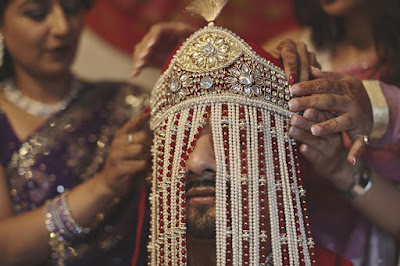5 things that most Gurdwaras don't do but still claim that they only follow Sri Akal Takht's Maryada
1. The colour of the Nishan Sahib
The Sikh Rehit Maryada states:
(ਡ) ਹਰ ਇਕ ਗੁਰਦੁਆਰੇ ਵਿਚ ਨਿਸ਼ਾਨ ਸਾਹਿਬ ਕਿਸੇ ਉਚੀ ਥਾਂ ਤੇ ਲੱਗਾ ਹੋਵੇ | ਨਿਸ਼ਾਨ ਸਾਹਿਬ ਦੇ ਪੁਸ਼ਾਕੇ ਦਾ ਰੰਗ ਬਸੰਤੀ ਜਾਂ ਸੁਰਮਈ ਹੋਵੇ ਅਤੇ ਨਿਸ਼ਾਨ ਸਾਹਿਬ ਦੇ ਸਿਰੇ ਉਤੇ ਸਰਬਲੋਹ ਦਾ ਭਾਲਾ ਜਾਂ ਖੰਡਾ ਹੋਵੇ |
"Every Gurdwara should have a Nishan Sahib on a raised level. The material of the Nishan Sahib should be yellow (Basanti) or greyish blue (Surmei), and the on the end of the Nishan Sahib should be a spear or Khanda made of Sarbloh (pure-iron)."

Sadly, nowadays it is becoming a rare sight to see a Nishan Sahib that is the correct colour. The colour of Nishan Sahibs are either orange
(Kesri), dark orange, or peach colour. These are not colours that represent the Sikh sovereign nation. There is no
Rehatnama that instructs Sikhs to have a
Kesri colour flag. The
Kesri flag, or orange colour, is a Hindu national colour and resembles the flag outside a Hindu temple and is the same colour as the RSS and Hindu right wing flags. The peach colour flag is used by Hindu saints and
Deras.
2. The Nagara
The Sikh Rehit Maryada states:
(ਢ) ਗੁਰਦੁਆਰੇ ਵਿਚ ਨਗਾਰਾ ਹੋਵੇ, ਜੋ ਸਮੇਂ ਸਿਰ ਵਜਾਇਆ ਜਾਵੇ |
"A Nagara (war drum) should be kept in the Gurdwara, which should be played at the appropriate times."
In most Gurdwaras the Nagara is absent and if they do have a Nagara it is not played during Prakaash time in the morning, during Ardaas time, and Sukhaasan time.
The massive drum with a metallic hemispheric body was called ‘Ranjit Nagara’, the drum of victory, a name given the kettledrum percussion instrument installed by Guru Gobind Singh Ji at Sri Anandpur Sahib in 1684. The Nagara, Punjabi for the Persian ‘naqqarah’ was a symbol of royalty. As well as fulfilling his spiritual office, Guru Gobind Singh Ji had, like his grandfather, Guru Hargobind Sahib Ji, adopted the emblems of worldly dignity. He wore an Kalgi and arms, sat under canopy and went out riding in state. The installation of a Nagara was another sign of authority. Keeping and using a Nagara in the Gurdwara had become part of Sikh tradition. The Nagara is beaten as a declaration of the sovereignty of the Khalsa, as a symbol of the sovereignty of truth and righteousness.
3. Akhand Paaths
The Sikh Rehit Maryada states:
ਜੇ ਕੋਈ ਆਦਮੀ ਆਪ ਪਾਠ ਨਹੀਂ ਕਰ ਸਕਦਾ, ਤਾਂ ਕਿਸੇ ਚੰਗੇ ਪਾਠੀ ਕੋਲੋਂ ਸੁਣ ਲਵੇ ਪਰ ਇਹ ਨਾ ਹੋਵੇ ਕਿ ਪਾਠੀ ਆਪੇ ਇਕੱਲਾ ਬਹਿ ਕੇ ਪਾਠ ਕਰਦਾ ਰਹੇ ਤੇ ਸੰਗਤ ਜਾਂ ਟੱਬਰ ਦਾ ਕੋਈ ਆਦਮੀ ਨਾ ਸੁਣਦਾ ਹੋਵੇ |
"If someone cannot do Paath themselves, then should listen from a good Paath reader, but it should not be the case that the Paath reader is sitting by themselves reading with no Sangat or family of the individual present."
Akhand Paaths have become misused and the respect shown to Gurbani has deteriorated over time. Rather than encouraging the Sangat to read Sri Guru Granth Sahib Ji themselves and hold Sadhaaran Paath, Gurdwaras happily do Akhand Paaths knowing at night time there is no Sangat or family members listening to the Paath. It has been inspiring to see Akhand Paaths conducted by Gursikhs during Smaagams before Rainsbaaees usually, where Gursikhs throughout the Akhand Paath sit near Sri Guru Granth Sahib Ji and listen to the Paath. However, for the majority Sangat that is not the case.
4. Anand Kaaraj
The Sikh Rehit Maryada states:
ਪ੍ਰਕਰਮਾਂ ਕਰਨ ਸਮੇਂ ਰਾਗੀ ਜਾਂ ਸੰਗਤ ਲਾਵਾਂ ਨੂੰ ਕ੍ਰਮ ਅਨੁਸਾਰ ਸੁਰ ਨਾਲ ਗਾਈ ਜਾਣ ਅਤੇ ਵਰ ਕੰਨਿਆਂ ਹਰ ਇਕ ਲਾਂਵ ਮਗਰੋਂ ਮੱਥਾ ਟੇਕ ਕੇ ਅਗਲੀ ਲਾਂਵ ਸੁਣਨ ਲਈ ਖੜ੍ਹੇ ਹੋ ਜਾਣ | ਉਪਰੰਤ ਮੱਥਾ ਟੇਕ ਕੇ ਆਪਣੀ ਥਾਂ ਤੇ ਬੈਠ ਜਾਣ ਤੇ ਰਾਗੀ ਸਿੰਘ ਜਾਂ ਅਨੰਦ ਕਰਾਉਣ ਵਾਲਾ ਅਨੰਦ ਸਾਹਿਬ ਦੀਆਂ ਪਹਿਲੀਆਂ ਪੰਜ ਪਉੜੀਆਂ ਤੇ ਅੰਤਲੀ ਪਉੜੀ ਦਾ ਪਾਠ ਕਰੇ |
"The boy and girl, after every Parkarma, should Matha Tek before Sri Guru Granth Sahib Ji, lowering their forehead to touch the ground and then stand back up to listen to the recitation of the next Laav. After the fourth Parkarma, the boy and girl should, after doing Matha Tek before Sri Guru Granth Sahib Ji, sit down at the appointed place and the Raagis or the person who has conducted the ceremony should recite the first five and the last Pauris of Anand Sahib"
According to the Sikh Rehit Maryada one is supposed to stand up to listen to the reading of each Laav, then do Matha Tekh, followed by Parkarma. When one goes before a judge, the person being addressed and spoken to by the judge, has to stand up. Similarly, when someone goes to receive the gift of Amrit from the Panj Piaare, you have to stand up when speaking to the Panj Piaare and when they interview and speak to you.
5. Langar and Degh
The Sikh Rehit Maryada states:
ਸਿਰਗੁੰਮ , ਨੜੀ ਮਾਰ (ਜੋ ਸਿੱਖ ਹੋ ਕੇ ਇਹ ਕੰਮ ਕਰਨ) ਦਾ ਸੰਗ ਨਹੀਂ ਕਰਨਾ |
"Do not associate with (one who being a Sikh becomes) a Sirgum (cut-haired) or tobacco user."
It further states:
(ਠ) ਤਨਖਾਹੀਏ ਇਹ ਹਨ:- ੧. ਮੀਣੇ, ਮਸੰਦ, ਧੀਰਮੱਲੀਏ, ਰਾਮਰਾਈਏ, ਆਦਿਕ ਪੰਥ ਵਿਰੋਧੀਆਂ ਨਾਲ ਜਾਂ ਨੜੀ ਮਾਰ, ਕੁੜੀ ਮਾਰ, ਸਿਰਗੁੰਮ ਨਾਲ ਵਰਤਨ ਵਾਲਾ ਤਨਖਾਹੀਆ ਹੋ ਜਾਂਦਾ ਹੈ |
"The following are Tankhaahias (individuals liable to be reprimanded involving automatic social boycott): 1. Anyone maintaining relations or communion with Meene, Masand, followers of Dheermal or Raam-Raae, or any other anti-Panthic individuals or groups, Narhee-maar (users of tobacco), Kurhee-maar (those who kill or abort their daughters), and Sirgum (those who cut their hair)."
According to the Sikh Rehat Maryada foot note, maintaining relations or communion means "ਰੋਟੀ ਬੇਟੀ ਦੀ ਸਾਂਝ" (i.e. to eat from or marry into). Nowadays, there are Gurdwaras which have those who cut their hair or use tobacco or intoxicants (i.e. alcohol) giving out Degh, making Langar and distributing Langar. Some Gurdwaras even have paid chefs or Laangaris who have cut hair and or consume intoxicants (i.e. alcohol etc). According to the Sikh Rehat Maryada, anyone cooked food and from the hands of such persons would be deemed liable for religious disciplinary action (i.e. Tankhaah). Due to pleasing others, the observation of the Sikh Rehat Maryada has been relaxed and yet still claim to be following the Panth's Maryada.























































